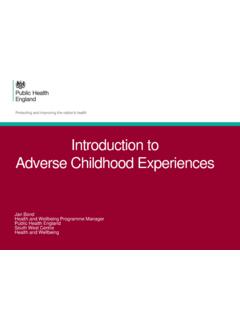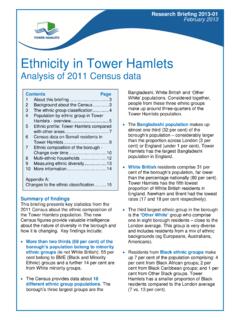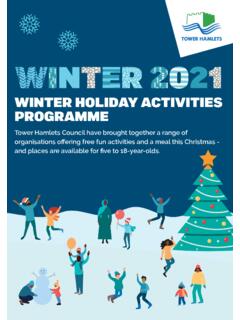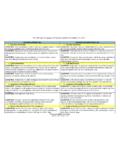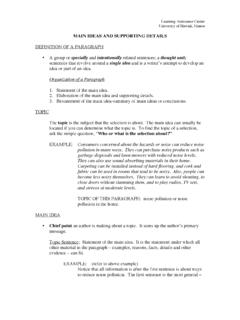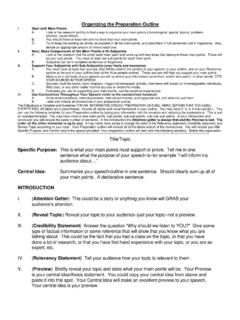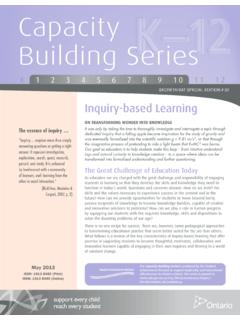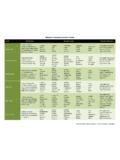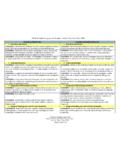Transcription of Moving on Supporting Children’s Transitions in the Early Years
1 Moving On: Supporting Children's Transitions in the Early Years01 Contents Introduction03cPrinciples of Early Years Transition07cAims of Guidance08 Moving On09cMajor Life Transitions11cParents13 Case Study: Using Parent Information PointBlue Gate Fields Infant School17cHome Visiting19 Case Study: Transition from Childminder to SchoolChristine Ishmail and Nolly23cTransition from Home to Setting or School25 Case Study: Transition from Home to Playgroup to NurseryEarly Years Inclusion Team Support and Jihad29cTransition from Children s Centres to Settings or School31 Case Study: Transition from Children s Centre to Reception34cTransitions Within Settings/School37cTransitions Throughout the Day41 Case Study: Transitions Throughout the DayMudchute Nursery44cTransition from Setting to School45 Case Study: Transition from Playgroup to SchoolMarion Richardson Primary School and Kaisan48 Case Study: A Multi Agency Approach, Transition from Day Care to NurseryBlue Gate Fields Infants and Yusrah50 Case Study: Transition from Playgroup to NurseryLincoln Hall Playgroup52 Case Study: Transition from Playgroup to SchoolTate House Playgroup55cTransition from Reception to Year 157 Case Study: Transition from Reception to Year 1 Mowlem Primary School60cChildren Using Transport Services63 Moving On: Supporting Children's Transitions in the Early Years02 Activities67cActivities for Children69cPicture Books for Early Years on Transitions , New Experiences and Changes71 Policy Guidance73cGuidance for Developing a Transition Policy in the Early Years Foundation Stage75 Directory79cOrganisations81cSupport Services84 Appendices93cGuidance for using the All BookscAll BookcAll Book Kaisan HoquecGuidance for Using the DiaryCase Study: Archie s DiarycTransition PlancTransition Plan.
2 Nadine Kaur cAcknowledgementsMoving On: Supporting Children's Transitions in the Early Years03 IntroductionMoving On: Supporting Children's Transitions in the Early Years05 Children make many Transitions intheir lives. Some are milestone Transitions such as starting atplaygroup or school. Some may eveninvolve a move to this also occur on a daily basisbetween home, childminders, settings,schools, after school clubs and perhapschildren s centre activities. Others mayinclude a change of key person orroom within a setting or are an important part oflife and offer opportunities for newexperiences and personal growth butthey may also include feelings ofanxiety and uncertainty for childrenand their guidance will help practitioners to furtherdevelop their knowledge and understanding ofthe impact that Transitions have on children swellbeing. It will also provide practitioners withinformation and practical ways of supportingchildren s Transitions .
3 A vital theme in theguidance is acknowledging the importance ofestablishing and building links between homeand different care and education guidance also recognises that observing andlistening to children is essential in enabling us totake into account their views, feelings andpreferences when planning Transitions . Strongrelationships with families will help to supportthem through the transition process. Working inpartnership with families enables practitioners todevelop an in depth understanding of theindividual experiences of Transitions for On: Supporting Children's Transitions in the Early Years06 The Early Years Foundation Stage clearlyhighlights the importance of facilitating smoothtransitions in order to foster children s emotionalwellbeing and maintain the progression of theirlearning and development. Well supportedtransitions contribute to children s personalgrowth and help develop their self esteem andconfidence, their independence and further informationFor further information please refer to the EarlyYears Foundation Stage online: All Transitions by Anne O Years Transition and Special EducationalNeeds (EYTSEN Project) the Early Years Service for up to daterecommendations of useful section in this guidance can be used on itsown.
4 Where appropriate, there are references torelated sections which provide use of 'parents' in this guidance refers toparents and carers. The use of the plural does notimply that a child will necessarily have more thanone On: Supporting Children's Transitions in the Early Years07 Principles of Early Years TransitioncChildren s experiences and memories, views and feelingsare respected and responded s individual interests, learning, developmentand strengths are recognised, valued and built are systems and structures in place to ensure acoordinated and consistent approach to children stransition. However, the individual child is the startingpoint for thinking about transition; processes andsystems must fit the child and not vice acknowledge that all children are uniqueand that their experiences of transition will be knowledge and skills are valued and they are fullpartners in their children s transition.
5 Parents aresupported throughout the have a responsibility to develop knowledgeof children s background, culture, religion, homelanguage, strengths and individual and settings establish good workingrelationships to support successful transition for On: Supporting Children's Transitions in the Early Years08 Aims of GuidancecTo provide guidance that is built upon effective practice,so that practitioners can support successful transitionsfor all children in the Early establish a consistent approach to supportingtransitions throughout Tower provide materials and tools to support children,parents and practitioners in making transition as positivean experience as On: Supporting Children's Transitions in the Early Years09 Moving OnMoving On: Supporting Children's Transitions in the Early Years11 Major Life TransitionsAs well as making Transitions between home and setting/school, for somechildren this may coincide with other important life Transitions .
6 Perhaps achild has recently arrived in the country. This could be part of a privatefostering arrangement within their extended family or it may be that theirfamily are refugees or asylum seekers. Other Transitions include children fromGypsy, Roma or traveller families who may be temporarily resident in theborough. Other children may have been placed with new foster parents oradoptive parents as a result of major events in the child s life. Moving On: Supporting Children's Transitions in the Early Years12It is important to have as much information aspossible and to work in partnership with otheragencies that may be Supporting the family. Eachsituation will be unique and children will respondin different ways. However, they may beextremely anxious and fearful about separationfrom parents or carers. It is important forpractitioners to appreciate the added impact onthe child s emotional well being that theseexperiences will have.
7 Practitioners may not haveexperienced anything so traumatic in their ownlives and so it is essential that they makethemselves aware of how a child s cognitive,personal, social and emotional development maybe for EffectivePracticeThe good practice suggested in other sections ofthis guidance will be helpful but, in addition, thefollowing are essential when Supporting childrenwho have undergone major life Transitions :cThe key person builds a positive and trustingrelationship with the good working partnerships withany agencies Supporting the use of organisations with specialistknowledge that relates to the child practitioners have knowledge of thecontext of the child s transition. Personalhistory is essential but some awareness ofthe political/historical context of thesituation could also be very is important to be sensitive to the families circumstances and to avoid being may need reassurance wheninformation is requested and practitionersneed to be clear about why it is the child and their family feelwelcomed in the setting and thatpractitioners approach them with warmthand help them to feel safe and cared a family who is very new in the countrythere may be a very different understandingand expectations of the education system.
8 CFamilies have differing views on child rearingpractices, child development and whatmight be expected of children. Practitionersneed to appreciate the importance of theseviews to parents when building relationshipswith families. cSettling in arrangements will need to bevery flexible and time made for the child todevelop new main security for the child will beconsistency of relationships and in for Supporting the child scommunication needs especially when achild is learning English as an additionallanguage and they are used to thinking andprocessing information in a differentlanguage. Use visual prompts to supportlanguage and provide regular and consistentroutines in order that the child can predictactivities rather than having to rely only onverbal information. (For detailed advice seeSupporting Children Learning English as anAdditional Language Guidance forPractitioners in the Early Years FoundationStage.)
9 Moving On: Supporting Children's Transitions in the Early Years13 ParentsWorking together with parents in an atmosphere of mutual respect helpschildren to feel secure and confident through the period of are the most significant people in the child s life and have an in depth knowledge and understanding of their child. Close parentalinvolvement ensures that practitioners can be well informed about individualchildren, including any issues they may have around transition. A strongpartnership also enables parents and practitioners to plan together tosupport On: Supporting Children's Transitions in the Early Years14 ideas for EffectivePracticeParents Information SessionInvite parents to an information sharing sessionwhere they can ask questions and gaininformation about the ethos, curriculum andhow parents are supported and involved in thesetting/school. This session would usefullyinvolve established parents in sharinginformation about the setting/school from theirperspective and would also provide prospectiveparents with opportunities to explore how theywould like to be PackProvide parents with a Welcome Pack when theyvisit the setting/school or during a home compiling a Welcome Pack it would behelpful to invite existing parents to help selectand develop materials as they will be able todraw on their own experiences and share ideasabout materials that are helpful for new possible, arrange for these materials to betranslated into community languages.
10 A DVDabout the setting or school could also be a usefulsource of information for parents as well as aresource for parents and children to use whentalking about BooksInvite parents to put together an All with their child to include photographs offamily and home, child s previous experiencesand interests, likes and dislikes, and what theywould like you to know about their child. Ensureplanning is responsive to the informationprovided in the All books and takes intoaccount the interests, needs and concerns of thechild. (See All Books: Information forPractitioners.) Moving On: Supporting Children's Transitions in the Early Years15 Additional Needs Be sensitive to the particular needs of parentswho have a child with additional needs. Theymay be dealing with a range of concerns anddemands in relation to their child. Parents mayfeel anxious about how their child will bereceived by others as well as settling and supportarrangements.




